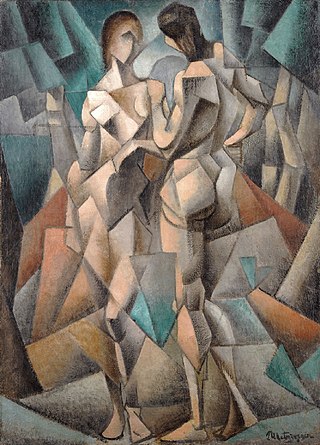Related Research Articles

Georges Braque was a major 20th-century French painter, collagist, draughtsman, printmaker and sculptor. His most notable contributions were in his alliance with Fauvism from 1905, and the role he played in the development of Cubism. Braque's work between 1908 and 1912 is closely associated with that of his colleague Pablo Picasso. Their respective Cubist works were indistinguishable for many years, yet the quiet nature of Braque was partially eclipsed by the fame and notoriety of Picasso.

Jan Josephszoon van Goyen was a Dutch landscape painter. The scope of his landscape subjects was very broad as he painted forest landscapes, marine paintings, river landscapes, beach scenes, winter landscapes, cityscapes, architectural views and landscapes with peasants. The list of painters he influenced is much longer. He was an extremely prolific artist who left approximately twelve hundred paintings and more than one thousand drawings.

Dream Caused by the Flight of a Bee Around a Pomegranate a Second Before Awakening is a surrealist painting by Salvador Dalí, from 1944. A shorter alternate title for the painting is Dream Caused by the Flight of a Bee. The woman in the painting, dreaming, is believed to represent his wife, Gala, a regular presence in his work. The painting is currently in the Thyssen-Bornemisza Museum, in Madrid.

John Frederick Kensett was an American landscape painter and engraver born in Cheshire, Connecticut. He was a member of the second generation of the Hudson River School of artists. Kensett's signature works are landscape paintings of New England and New York State, whose clear light and serene surfaces celebrate transcendental qualities of nature, and are associated with Luminism. Kensett's early work owed much to the influence of Thomas Cole, but was from the outset distinguished by a preference for cooler colors and an interest in less dramatic topography, favoring restraint in both palette and composition. The work of Kensett's maturity features tranquil scenery depicted with a spare geometry, culminating in series of paintings in which coastal promontories are balanced against glass-smooth water. He was a founder of the Metropolitan Museum of Art.

Richard Estes is an American artist, best known for his photorealist paintings. The paintings generally consist of reflective, clean, and inanimate city and geometric landscapes. He is regarded as one of the founders of the international photo-realist movement of the late 1960s, with such painters as John Baeder, Chuck Close, Robert Cottingham, Audrey Flack, Ralph Goings, and Duane Hanson. Author Graham Thompson writes "One demonstration of the way photography became assimilated into the art world is the success of photorealist painting in the late 1960s and early 1970s. It is also called super-realism or hyper-realism and painters like Richard Estes, Denis Peterson, Audrey Flack, and Chuck Close often worked from photographic stills to create paintings that appeared to be photographs."

The Thyssen-Bornemisza National Museum, or simply the Thyssen, is an art museum in Madrid, Spain, located near the Prado Museum on one of the city's main boulevards. It is known as part of the "Golden Triangle of Art", which also includes the Prado and the Reina Sofía national galleries. The Thyssen-Bornemisza fills the historical gaps in its counterparts' collections: in the Prado's case this includes Italian primitives and works from the English, Dutch and German schools, while in the case of the Reina Sofía it concerns Impressionists, Expressionists, and European and American paintings from the 20th century.

Giovanni Battista Piazzetta was an Italian Rococo painter of religious subjects and genre scenes.
Twentieth-century art—and what it became as modern art—began with modernism in the late nineteenth century.

Robert Salmon was a maritime artist, active in both England and America. Salmon completed nearly 1,000 paintings, all save one of maritime scenes or seascapes. He is widely considered the Father of American Luminism.

Fauvism is a style of painting and an art movement that emerged in France at the beginning of the 20th century. It was the style of les Fauves, a group of modern artists whose works emphasized painterly qualities and strong colour over the representational or realistic values retained by Impressionism. While Fauvism as a style began around 1904 and continued beyond 1910, the movement as such lasted only a few years, 1905–1908, and had three exhibitions. The leaders of the movement were André Derain and Henri Matisse.

Houses at l'Estaque is an oil-on-canvas painting by Georges Braque executed in 1908. It is considered either an important Proto-Cubist landscape or the first Cubist landscape. The painting prompted art critic Henri Matisse to mock it as being composed of cubes which led to the name of the movement.

Baigneuses: Deux nus dans un paysage exotique is an oil painting created circa 1905 by the French artist and theorist Jean Metzinger (1883–1956). Two Nudes in an Exotic Landscape is a Proto-Cubist work executed in a highly personal Divisionist style during the height of the Fauve period. The painting is part of Carmen Cervera's art collection and its exhibited in the Thyssen-Bornemisza Museum, Madrid

Two Nudes is an early Cubist painting by the French artist and theorist Jean Metzinger. The work was exhibited at the first Cubist manifestation, in Room 41 of the 1911 Salon des Indépendants, Paris. At this exhibition the Cubist movement was effectively launched before the general public by five artists: Metzinger, Gleizes, Le Fauconnier, Delaunay and Léger. This was the first exhibition during which artists, writers, critics and the public at large encountered and spoke about Cubism. The result of the group show is a succès de scandale.

Les Peintres Cubistes, Méditations Esthétiques, is a book written by Guillaume Apollinaire between 1905 and 1912, published in 1913. This was the third major text on Cubism; following Du "Cubisme" by Albert Gleizes and Jean Metzinger (1912); and André Salmon, Histoire anecdotique du cubisme (1912).

The Pietà is a painting by José de Ribera, "The Españoleto", painted, signed and dated in 1633.

Annunciation is a 1575–1576 oil painting on canvas by the Greek artist of the Spanish Renaissance El Greco. It is one of the earliest paintings by the artist and depicts the Annunciation, a key topic in Christian art. The painting is now in the Thyssen-Bornemisza Museum, in Madrid.

The Viaduct at L'Estaque is an oil-on-canvas painting by Georges Braque, executed in 1907. The painting has the dimensions of 63.5 by 78.74 cm. It is housed at the Minneapolis Institute of Art.

Metropolis is an oil on canvas painting by the German artist George Grosz, executed in 1916–1917. It belongs to the collection of the Thyssen-Bornemisza Museum in Madrid.
Woman with a Mandolin is an oil-on-canvas painting by French artist Georges Braque, created in 1910. The painting is in the Thyssen-Bornemisza Museum, in Madrid.

Portuguese Woman, also known as Tall Portuguese Woman, is an oil and wax on canvas painting by the French painter Robert Delaunay, created in 1916. It is held in the Thyssen-Bornemisza Museum, in Madrid. There are others similary named paintings by the same artist from this phase, in other museums.
References
- 1 2 3 Seascape. L'Estaque, Museo Thyssen-Bornemisza
- ↑ Guillermo Solana, Landscape Paintings in the Collection of Carmen Thyssen-Bornemisza, Scala, University of Michigan, 2006, pp. 92-93